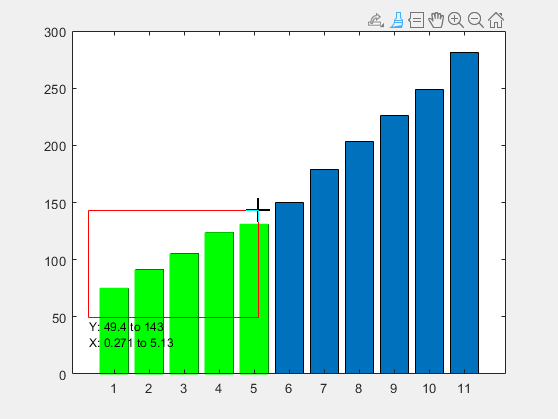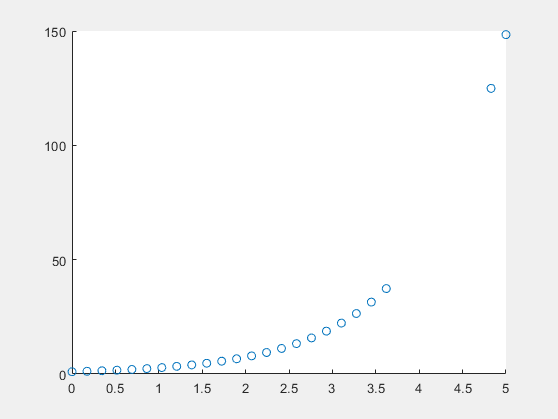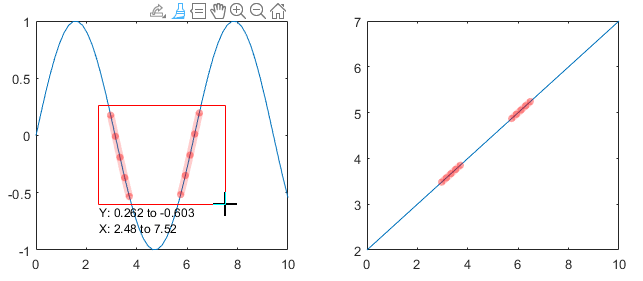brush
以交互方式标记图中的数据值
说明
数据刷亮允许您使用自选颜色对图中的数据值进行标记。您可以标记单个数据值,也可以框选多个值进行标记。对值进行标记后,您可以将其删除或保存到工作区中的变量中。即使平移、缩放、添加数据提示或编辑绘图,刷亮标记也会一直保留,直到将其删除为止。
大多数图都支持数据刷亮,包括线图、条形图、面积图、直方图和曲面图。支持刷亮的图通常在坐标区工具栏中显示笔刷 ![]() 图标。
图标。
创建对象
描述
brush on 将在当前图窗中启用刷亮。在启用刷亮状态下,点击一个数据值可对其进行标记。如果要标记多个数据值,可框选这些值。要添加额外的标记或删除不需要的标记,请在刷亮数据值时按住 Shift 键。
brush off 禁用刷亮。如果图上存在刷亮标记,此命令不会将它们删除。
brush 在 on 和 off 之间切换刷亮模式。
brush( 设置后续刷亮标记的颜色。设置刷亮颜色不会影响当前标记,除非您刷亮数据、更改刷亮颜色,然后使用 Shift 键添加或删除标记。在这种情况下,所有标记都会更新为新颜色。color)
brush( 可在上述任一语法的基础上设置指定图窗中所有坐标区的刷亮模式。将附加参量指定为 fig,___)'on'、'off' 或刷亮标记颜色。例如,要为图窗 fig 中的所有坐标区启用刷亮模式,请使用 brush(fig,'on')。要设置所有坐标区的刷亮标记颜色,请使用 brush(fig,'green')。
brush( 可为指定的坐标区设置刷亮模式。例如,要为坐标区 ax,___)ax 启用刷亮模式,请使用 brush(ax,'on')。要设置坐标区的刷亮标记颜色,请使用 brush(ax,'green')。 (自 R2023a 起)
在 R2025a 之前的版本中: 将此语法用于在 App 设计工具中创建的 App 或使用 uifigure 函数创建的 App。
输入参量
属性
示例
详细信息
提示
要刷亮直方图,必须首先启用数据链接。
替代功能
坐标区工具栏
对于某些图,通过点击坐标区工具栏中的笔刷 ![]() 图标来启用刷亮模式。
图标来启用刷亮模式。








![Sample of RGB triplet [0 0.4470 0.7410], which appears as dark blue](colororder1.png)
![Sample of RGB triplet [0.8500 0.3250 0.0980], which appears as dark orange](colororder2.png)
![Sample of RGB triplet [0.9290 0.6940 0.1250], which appears as dark yellow](colororder3.png)
![Sample of RGB triplet [0.4940 0.1840 0.5560], which appears as dark purple](colororder4.png)
![Sample of RGB triplet [0.4660 0.6740 0.1880], which appears as medium green](colororder5.png)
![Sample of RGB triplet [0.3010 0.7450 0.9330], which appears as light blue](colororder6.png)
![Sample of RGB triplet [0.6350 0.0780 0.1840], which appears as dark red](colororder7.png)









